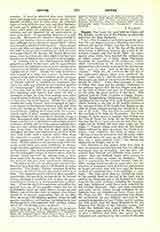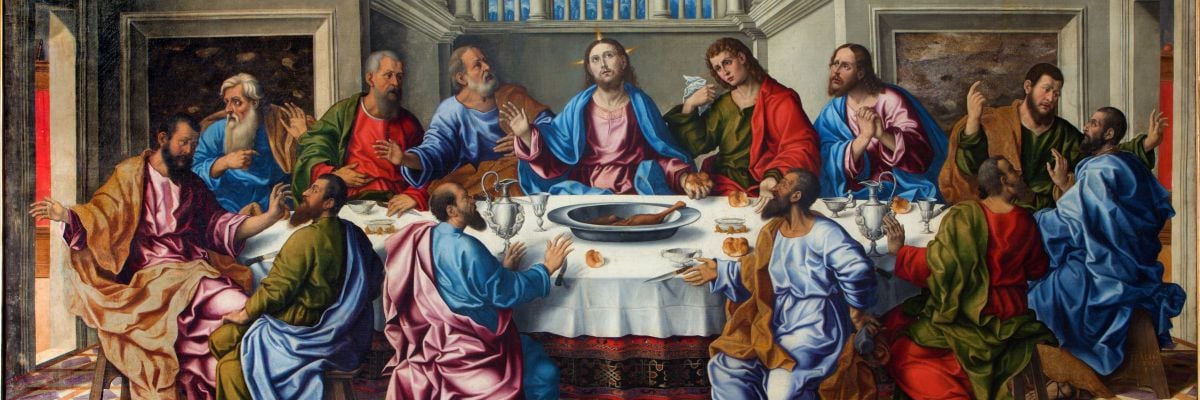

Supper, THE LAST, the meal held by Christ and His disciples on the eve of His Passion at which He instituted the Holy Eucharist.
TIME.—The Evangelists and critics generally agree that the Last Supper was on a Thursday, that Christ suffered and died on Friday, and that He arose from the dead on Sunday. As to the day of the month there seems a difference between the record of the synoptic Gospels and that of St. John. In consequence some critics have rejected the authenticity of either account or of both. Since Christians, accepting the inspiration of the Scriptures, cannot admit contradictions in the sacred writers, various attempts have been made to reconcile the statements. Matt., xxvi, 17, says, “And on the first day of the Azymes“; Mark, xiv, 12, “Now on the first day of the unleavened bread, when they sacrificed the pasch”; Luke, xxii, 7, “And the day of the unleavened bread came, on which it was necessary that the pasch should be killed”. From these passages it seems to follow that Jesus and his disciples conformed to the ordinary custom, that the Last Supper took place on the 14th of Nisan, and that the Crucifixion was on the 15th, the great festival of the Jews. This opinion, held by Tolet, Cornelius a Lapide, Patrizi, Corluy, Hengstenberg, Ohlshausen, and Tholuck, is confirmed by the custom of the early Eastern Church, which, looking to the day of the month, celebrated the commemoration of the Lord’s Last Supper on the 14th of Nisan, without paying any attention to the day of the week. This was done in conformity with the teaching of St. John the Evangelist. But in his Gospel, St. John seems to indicate that Friday was the 14th of Nisan, for (xviii, 28) on the morning of this day the Jews “went not into the hall, that they might not be defiled, but that they might eat the pasch”. Various things were done on this Friday which could not be done on a feast, viz., Christ is arrested, tried, crucified; His body is taken down” (because it was the parasceve) that the bodies might not remain upon the cross on the sabbath day (for that was a great sabbath day)”; the shroud and ointments are bought, and so on.
The defenders of this opinion claim that there is only an apparent contradiction and that the differing statements may be reconciled. For the Jews calculated their festivals and Sabbaths from sunset to sunset: thus the Sabbath began after, sunset on Friday and ended at sunset on Saturday. This style is employed by the synoptic Gospels, while St. John, writing about twenty-six years after the destruction of Jerusalem, when Jewish laws and customs no longer prevailed, may well have used the Roman method of computing time: from midnight to midnight. The word pasch does not exclusively apply to the paschal lamb on the eve of the feast, but is used in the Scriptures and in the Talmud in a wider sense for the entire festivity, including the chagigah; any legal defilement could have been removed by the evening ablutions; trials, and even executions and many servile works, though forbidden on the Sabbath, were not forbidden on feasts (Num., xxviii, 16; Deut., xvi, 23). The word parasceve may denote the preparation for any Sabbath and may be the common designation for any Friday, and its connection with pasch need not mean preparation for the Passover but Friday of the Passover season, and hence this Sabbath was a great Sabbath. Moreover it seems quite certain that if St. John intended to give a different date from that given by the Synoptics and sanctioned by the custom of his own Church at Ephesus, he would have said so expressly. Others accept the apparent statement of St. John that the Last Supper was on the 13th of Nisan and try to reconcile the account of the Synoptics. To this class belong Paul of Burgos, Maldonatus, Petau, Hardouin, Tillemont, and others. Peter of Alexandria (P.G., XCII, 78) says: “In previous years Jesus had kept the Passover and eaten the paschal lamb, but on the day before He suffered as the true Paschal Lamb He taught His disciples the mystery of the type.” Others say: Since the Pasch, falling that year on a Friday, was reckoned as a Sabbath, the Jews, to avoid the inconvenience of two successive Sabbaths, had postponed the Passover for a day, and Jesus adhered to the day fixed by law; others think that Jesus anticipated the celebration, knowing that at the proper time He would be in the grave.
PLACE.—The owner of the house in which was the Occupying the Traditional Site of the House in Jerusalem in which the Last Supper was held upper room of the Last Supper is not mentioned in Scripture; but he must have been one of the disciples, since Christ bids Peter and John say, “The Master says”. Some say it was Nicodemus, or Joseph of Arimathea, or the mother of John Mark. The hall was large and furnished as a dining room. In it Christ showed Himself after His Resurrection; here took place the election of Matthias to the Apostolate and the sending of the Holy Ghost; here the first Christians assembled for the breaking of bread; hither Peter and John came when they had given testimony after the cure of the man born lame, and Peter after his liberation from prison; here perhaps was the council of the Apostles held. It was for a while the only church in Jerusalem, the mother of all churches, known as the Church of the Apostles, or of Sion. It was visited in 404 by St. Paula of Rome. In the eleventh century it was destroyed by the Saracens, later rebuilt and given to the care of the Augustinians. Restored after a second destruction, it was placed in charge of the Franciscans, who were driven out in 1561. At present it is a Mohammedan mosque.
SEQUENCE OF EVENTS.—Some critics give the following harmonized order: washing of the feet of the Apostles, prediction of the betrayal and departure of Judas, institution of the Holy Eucharist. Others, believing that Judas made a sacrilegious communion, place the institution of the sacrament before the departure of Judas.
IN ART.—The Last Supper has been a favorite subject. In the catacombs we find representations of meals giving at least an idea of the surroundings of an ancient dining hall. Of the sixth century we have a bas-relief in the church at Monza in Italy, a picture in a Syrian codex of the Laurentian Library at Florence, and a mosaic in S. Apollinare Nuovo at Ravenna. One of the most popular pictures is that of Leonardo da Vinci in Santa Maria delle Grazie, Milan. Among the modern school of German artists, the Last Supper of Gebhardt is regarded as a masterpiece.
FRANCIS MERSHMAN


